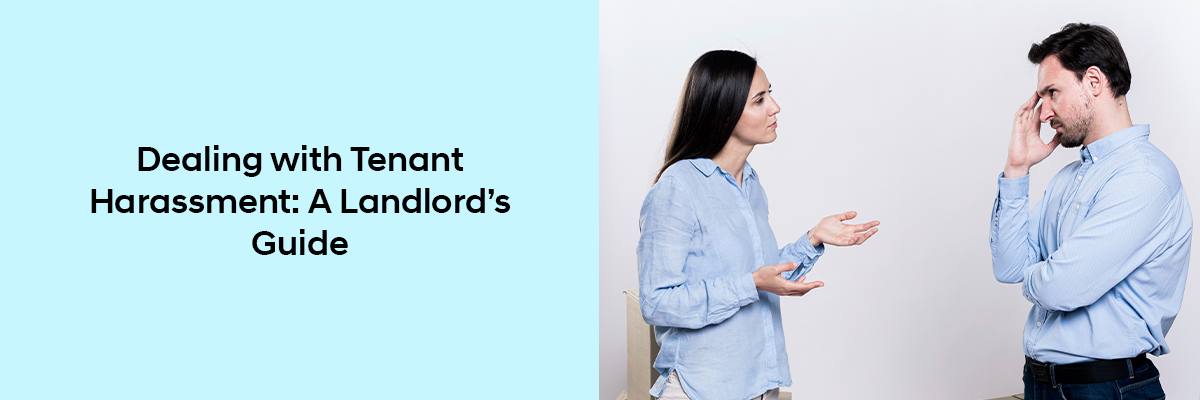When we hear the word “harassment” in a rental context, most of us imagine a tenant being harassed by a landlord or their rights were not given to him. But what happens when the tenant is the one doing the harassing?
This is a situation that catches many landlords and property managers off guard. And understandably so, because tenants have legal protections and rights and by default they are deemed as innocent unless proven otherwise, even handling clear cases of abusive behavior can feel like walking through a legal minefield. That said, tenant-on-landlord or tenant-on-tenant harassment is real, and when it happens, it affects not just individual victims of that harassment, but the overall health of rental property where this harassment is happening.
So how do you deal with it? First, understand what tenant harassment actually looks like. Then, we will learn how to respond to it.



What Does Tenant Harassment Look Like?
Tenant harassment can take many forms, and it doesn’t always come with shouting or broken windows. Sometimes, it’s subtle and psychological. Other times, it’s aggressive, physical, and impossible to ignore. And in some cases, the harassment is calculated, designed to create stress and disruption while skirting just below the legal threshold.
Importantly, harassment by a tenant can be directed at other tenants, property managers, or the landlord themselves. Each type of behavior can damage your rental community and create serious legal and operational headaches.
So, what does harassment by a tenant actually look like? Let’s break it down.
Mental / Psychological Harassment by a Tenant
This type of harassment doesn’t involve physical violence, but it can be just as damaging. Mental or psychological tenant harassment refers to behavior that causes emotional distress, fear, or discomfort, whether directed at other tenants, the landlord, or property management. It often leads to anxiety, stress, depression, or feelings of being unsafe in one’s own home.
Harassment Toward Other Tenants:
- Intimidation and Threats: Regularly confronting or threatening neighbors, especially in shared spaces like hallways, laundry rooms, or parking areas.
- Bullying and Verbal Abuse: Yelling, insulting, or using aggressive body language to scare or belittle others.
- Identity-Based Harassment: Making racist, sexist, homophobic, or otherwise discriminatory remarks or slurs aimed at tenants.
- Manipulative Behavior: Spreading false rumors, turning neighbors against each other, or intentionally isolating someone socially.
- Stalking or Surveillance: Watching others from windows, following them in or around the building, or keeping track of their schedules without consent.
- Noise Harassment: Blasting loud music, shouting, or creating disruptive noise, especially late at night, with the clear intention of disturbing neighbors.
- Disruptive Use of Shared Spaces: Placing personal or offensive items in common areas (e.g. hallways, entryways, or laundry rooms) that make others feel uncomfortable or unsafe.
Toward Landlords or Property Managers:
- Verbal Abuse and Threats: Yelling, swearing, or making aggressive remarks, often in response to rent increases, maintenance issues, or enforcement of rules. This type of verbal abuse by tenants can create a hostile working environment.
- False Accusations: Tenants may claim discrimination, harassment, or other legal violations without evidence, often as a way to deflect accountability or pressure management.
To read more about discriminatory advertising, do give our in-depth blog a raed.
- Stonewalling and Manipulation: Ignoring phone calls, texts, or official notices, and then turning around to accuse the landlord of neglect or poor communication.
- Frivolous Legal Threats (aka Paper Terrorism): Repeatedly filing baseless complaints, legal threats, or small claims actions to intimidate, harass, or wear down the property manager. This tactic is especially common with so-called “professional tenants” who know how to exploit loopholes.
Physical Harassment or Intimidation
Physical tenant harassment refers to any behavior that causes, or threatens to cause, physical harm to other tenants, the landlord, or the property itself. This includes direct violence, damage to personal or shared property, and any action that could endanger someone’s health, safety, or ability to live peacefully in the building.
Whether it’s a physical confrontation, a dangerous pet, or intentional property damage, this type of harassment can escalate quickly and must be dealt with seriously.
Harassment Toward Other Tenants:
- Assault or Threats of Violence: Pushing, hitting, or making verbal threats that suggest physical harm, even if no contact is made.
- Property Damage: Vandalizing vehicles, mailboxes, doors, or any personal belongings of fellow tenants.
- Aggressive Pets: Allowing dangerous pets to roam freely or using them to intimidate others. This can also violate local safety or leash laws.
- Territorial Behavior: Blocking access to shared spaces (laundry rooms, entrances, parking spots) or trying to “claim” areas not assigned to them.
- Endangering the Common Area: Leaving hazardous or harmful items in shared spaces, hoarding flammable or toxic materials, or creating clutter that poses a health or fire risk.
- Excessive Noise with Physical Impact: Playing music at extremely high volumes or creating sounds so intense they don’t just disturb people mentally, they cause physical discomfort (e.g. headaches, sleep deprivation, anxiety).
Harassment Toward Landlords or Property Managers:
Physical harassment isn’t always a punch thrown, it can also include physical threats, damage to property, or blocking access. When aimed at landlords or building staff, it’s both a safety issue and a violation of lease terms or the law.
- Threats or Physical Confrontations: For example, during an argument over rent or a rule, a tenant might say, “If you raise my rent, you’ll regret it,” or hurl personal insults like, “You money-hungry leech, I’ll show you what I can do.” That’s not just rude, it’s threatening behavior.
- Tampering with Property: Deliberately breaking appliances, changing locks without permission, damaging electrical or plumbing systems, or otherwise sabotaging the rental unit.
- Blocking Legal Access: Refusing to let the landlord or repair personnel into the unit for required maintenance or inspections, even when notice was properly given and local laws are followed.
Legal / Contractual Harassment by a Tenant
Not all forms of harassment are loud or violent. Some tenants use paperwork, technicalities, and legal gray areas as weapons. This kind of legal or contractual tenant harassment can be just as disruptive, especially when a tenant deliberately exploits their rights, local housing laws, or lease terms to manipulate, intimidate, or punish the landlord or property manager.
This type of harassment can cost time, money, and peace of mind, and it often puts landlords on the defensive even when they’ve done nothing wrong.
Harassment Toward Landlords or Property Managers:
- Blatant Lease Violations: Repeatedly ignoring clearly defined lease terms, such as unauthorized subletting, housing unapproved guests, or keeping restricted pets. These tenants often dare landlords to enforce the rules, knowing the legal process is slow and complex.
- Rent Withholding or Delay Tactics: Refusing to pay rent while continuing to live in the unit, often citing minor maintenance issues or exploiting legal delays. Some tenants become what’s known as “professional tenants”, people who understand how to game the system to live rent-free for as long as possible.
- Filing Baseless Complaints or Legal Threats: Initiating frivolous lawsuits, discrimination claims, or complaints to housing authorities, not because there’s a real issue, but to pressure, harass, or punish the landlord for trying to enforce the lease.
- Retaliation and Smear Campaigns: After being asked to follow the rules, these tenants may retaliate by filing false reports, bad-mouthing the landlord online, or threatening to “expose” them publicly, regardless of whether any wrongdoing occurred.
Why You Must Act, and Carefully
No matter who the target is, another tenant, you, or your staff, harassment cannot be tolerated. If ignored, it poisons the rental property or the entire community and puts you at legal and reputational risk. But reacting the wrong way can backfire and land you in hot water. So the key is to act quickly, but legally and methodically.
Consequences for Tenants Who Harass
If a tenant is found to be harassing others or violating the lease through aggressive behavior, they can face serious consequences:
- Tenant Eviction: If their behavior breaks lease terms or local laws.
- Criminal charges: For assault, stalking, or other criminal behavior.
- Restraining orders: Filed by other tenants, or you.
- Civil liability: You or others may sue for damages caused by their behavior.
To know more about if a tenant can refuse landlord entry, do give our in-depth blog a read.
How to Handle Harassment from a Tenant
Now that we understand the different forms tenant harassment can take, it’s important to recognize that handling these situations is anything but simple. If you don’t approach it carefully and strategically, things can spiral quickly. This is where it gets real, and where many landlords find themselves stuck. Without proper documentation or a clear process, it often turns into your word against theirs. That’s not a position you want to be in.
To deal with a harassing tenant effectively, you need to know what to do, what not to do, and how to handle the situation in a way that’s both professional and legally sound. The last thing you want is to escalate the issue, get drawn into unnecessary drama, or damage the reputation of your rental property in the eyes of other tenants, or future ones. So let’s walk through how to manage a harassing tenant the right way: firmly, calmly, and without giving them any ammunition to use against you.
1. Document Everything
In harassment situations, documentation isn’t just for your memory, you’re building a paper trail, a timeline, and potentially even a legal case. And it needs to hold up under scrutiny, whether you’re filing a formal complaint, moving toward eviction, or protecting yourself from retaliation.
Start by recording every incident clearly and objectively, as if you were submitting it as evidence. Include the date, time, what happened, who was present, and the impact the incident had, whether it disturbed neighbors, damaged property, or involved threats. If the interaction was verbal and happened in front of others, treat those witnesses as critical sources. Their accounts, when written down or recorded (with their permission), can support your complaint and help neutralize any “he said, she said” conflicts.
If your building has CCTV or other surveillance in shared spaces, use it, but use it responsibly. Save and back up any footage that captures aggressive behavior, property damage, unauthorized access, or confrontations. Timestamp the video files, label them properly, and store them in a secure folder. Remember that video evidence doesn’t just prove the incident happened, it shows how serious it was and how the person behaved in the moment.
For incidents involving physical damage or safety hazards, photos carry weight. Capture the damage in context, and be sure to include images that show its location relative to shared areas or other tenants’ spaces. Whether it’s a broken lock, scattered trash, or a dangerous pet left unattended, visual documentation strengthens your case.
In some jurisdictions, it may be legal to record conversations or interactions with the tenant, especially if they’re threatening or abusive. If that’s allowed where you live, those recordings can be crucial, but if it’s not, using them could put you at legal risk. Always check your local recording laws before going down that path. And when in doubt, opt for written summaries of every verbal exchange, sent via email or logged immediately after the fact.
All of this evidence, notes, messages, witness statements, emails, call recordings, written complaints, photos, videos, should be kept together in one organized file. If you ever need to file a complaint with housing authorities, respond to one, or initiate formal action like eviction, you’ll be ready. You’re not just protecting your property; you’re protecting your credibility and ensuring that the process plays out based on facts, not emotion.
This isn’t about creating drama. It’s about documenting truth, because truth, properly recorded, is your strongest defense.
2. Communicate Professionally
Don’t get emotional. That’s exactly what some difficult tenants want, to drag you into a heated exchange they can later twist to their advantage. Keep all communication factual, neutral, and preferably in writing. Emails and text messages are your best friend here. If you must speak in person or by phone, follow up with a written summary. Never argue. Never threaten. And never give them something they can use against you.
3. Issue Formal Warnings or Notices
When the tenant’s behavior crosses the line, whether it’s verbal abuse, threats, or constant disruption, you need to respond officially. Serve a lease violation notice that clearly states what clause has been broken, what behavior was observed, and what the next step will be. This isn’t about scaring them; it’s about building a strong legal paper trail. Make sure your notice complies with local landlord-tenant laws, don’t improvise.
4. Involve Law Enforcement When Needed
If the situation escalates into threats, physical confrontation, or property damage, it’s time to call the police. At that point, it’s not just a landlord issue, it’s a safety issue. Don’t hesitate. Document the report, get an incident number, and keep a copy. Even if the authorities don’t take major action immediately, their involvement strengthens your case and adds credibility to your claims.
5. Encourage Other Tenants to Speak Up
When other tenants are affected, their input can be incredibly valuable. Don’t pressure them, but let them know they have a right to report harassment and that their voices will be taken seriously. Encourage them to document what they see or experience, and if they’re willing, provide written statements or video testimonials. Their statements could be the deciding factor in proving ongoing misconduct.
6. Consult a Landlord-Tenant Attorney
Before you take any major step, especially if eviction is on the table, talk to a legal expert. A lawyer who specializes in landlord-tenant law can help you avoid costly mistakes, draft strong notices, and keep the process legally tight. Remember, some tenants want you to slip up so they can claim retaliation or procedural violations. Get advice before they get leverage.
7. File for Eviction (When Justified)
If the harassment continues, and you’ve built your case with documentation, notices, and legal guidance, it may be time to begin formal eviction. But do it the right way. Never try to “force them out” by cutting services or changing locks, that will only backfire. Follow your state’s eviction process to the letter, and let the system work in your favor.
To know more about tenant evictions for damage, do give our blog a read.
Final Thought
Dealing with a harassing tenant is one of the more challenging, frustrating parts of being a landlord, but it’s also one of the most important moments where your professionalism, patience, and preparation really matter. You can’t afford to react emotionally, cut corners, or hope the problem resolves itself. That rarely happens.
But you also don’t need to play the villain, escalate the drama, or risk your reputation trying to prove a point. You’re not here to win an argument, you’re here to protect your property, your tenants, and your peace of mind.
If you document carefully, communicate with discipline, and act through the proper legal channels, you put yourself in a position of strength, not just morally, but legally. You don’t have to tolerate harassment. You don’t have to accept abuse. And you absolutely don’t have to face it alone or unprepared.
In the end, the goal isn’t just to remove a problem tenant, it’s to send a message: that your rental property is a safe, respectful, and well-managed place to live.
Handle it right, and you won’t just deal with one bad tenant, you’ll strengthen the foundation of your entire rental community. If you want to stay updated with fair housing insights, do check out our fair housing webinars, led by industry experts.


